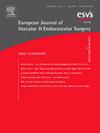主动脉夹层的发生率和危险因素分析:来自中国嘉道理生物库的发现。
IF 5.7
1区 医学
Q1 PERIPHERAL VASCULAR DISEASE
European Journal of Vascular and Endovascular Surgery
Pub Date : 2025-04-01
DOI:10.1016/j.ejvs.2024.12.003
引用次数: 0
摘要
目的:基于人群的前瞻性研究中关于主动脉夹层(AD)发病率的数据很少,其危险因素在中国也没有得到很好的研究。本研究的目的是通过基于人群的前瞻性研究,调查中国10个地区相对准确的AD发病率,并确定其潜在的危险因素。方法:数据来自一项前瞻性队列研究,涉及2004 - 2008年中国10个地区的51万名中年人(中国嘉道理生物库)。计算AD的发病率,并使用竞争风险分析评估潜在危险因素(体重指数[BMI]、高血压和糖尿病)与AD发生的关系。结果:该研究纳入512 724名参与者(女性59.0%,中位年龄51.5岁)。在中位随访121个月期间,119名参与者发展为AD。在整个队列、男性和女性参与者中,AD的发病率分别为每10万人年2.35(95%可信区间[CI] 1.93 - 2.77)、3.97 (95% CI 3.10 - 4.83)和1.25 (95% CI 0.86 - 1.65)。竞争风险分析确定女性(风险比[HR] 0.35, 95% CI 0.24 - 0.52;p结论:与以往的数据和临床观察相比,糖尿病(或随机血糖)或BMI与AD的发生没有显著相关性。男性和高血压与AD的发生独立相关。本文章由计算机程序翻译,如有差异,请以英文原文为准。
Aortic Dissection Incidence and Risk Factor Analysis: Findings from the China Kadoorie Biobank
Objective
Data on the incidence of aortic dissection (AD) from population based prospective studies are scarce and its risk factors are not well studied in China. The aim of this study was to investigate the relatively accurate incidence of AD in ten regions of China and to identify its potential risk factors using a population based prospective study.
Methods
Data from a prospective cohort study involving ∼510 000 middle aged adults in ten regions of China from 2004 – 2008 (the China Kadoorie Biobank) were used. The incidence of AD was calculated and the association between potential risk factors (body mass index [BMI], hypertension, and diabetes) and the occurrence of AD was evaluated using competing risk analysis.
Results
The study included 512 724 participants (59.0% female, median age 51.5 years). During a median follow up of 121 months, 119 participants developed AD. The incidence of AD was 2.35 (95% confidence interval [CI] 1.93 – 2.77), 3.97 (95% CI 3.10 – 4.83), and 1.25 (95% CI 0.86 – 1.65) per 100 000 person years for the whole cohort, male participants, and female participants, respectively. Competing risk analysis identified female sex (hazard ratio [HR] 0.35, 95% CI 0.24 – 0.52; p < .001) and hypertension (HR 6.21, 95% CI 3.94 – 9.80; p < .001) as independent predictors of AD. BMI, diabetes, and random blood glucose were not associated with AD.
Conclusion
In contrast to previous data and clinical observations, there was no significant correlation between diabetes (or random blood glucose) or BMI and the occurrence of AD. Male sex and hypertension were independently associated with the occurrence of AD.
求助全文
通过发布文献求助,成功后即可免费获取论文全文。
去求助
来源期刊
CiteScore
6.80
自引率
15.80%
发文量
471
审稿时长
66 days
期刊介绍:
The European Journal of Vascular and Endovascular Surgery is aimed primarily at vascular surgeons dealing with patients with arterial, venous and lymphatic diseases. Contributions are included on the diagnosis, investigation and management of these vascular disorders. Papers that consider the technical aspects of vascular surgery are encouraged, and the journal includes invited state-of-the-art articles.
Reflecting the increasing importance of endovascular techniques in the management of vascular diseases and the value of closer collaboration between the vascular surgeon and the vascular radiologist, the journal has now extended its scope to encompass the growing number of contributions from this exciting field. Articles describing endovascular method and their critical evaluation are included, as well as reports on the emerging technology associated with this field.

 求助内容:
求助内容: 应助结果提醒方式:
应助结果提醒方式:


